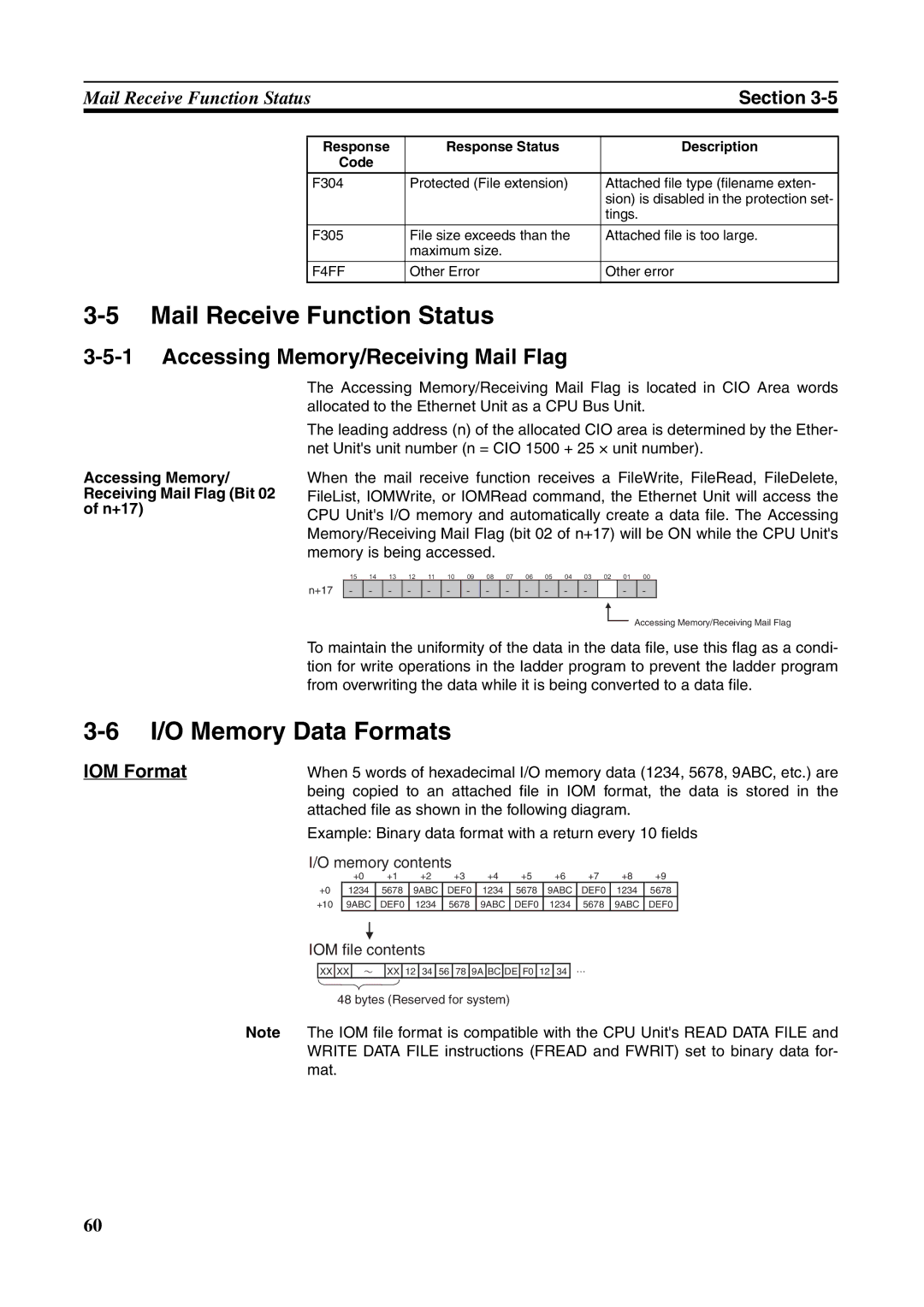
Mail Receive Function Status |
| Section | |
|
|
|
|
| Response | Response Status | Description |
| Code |
|
|
|
|
|
|
| F304 | Protected (File extension) | Attached file type (filename exten- |
|
|
| sion) is disabled in the protection set- |
|
|
| tings. |
|
|
|
|
| F305 | File size exceeds than the | Attached file is too large. |
|
| maximum size. |
|
|
|
|
|
| F4FF | Other Error | Other error |
|
|
|
|
3-5 Mail Receive Function Status
3-5-1 Accessing Memory/Receiving Mail Flag
Accessing Memory/ Receiving Mail Flag (Bit 02 of n+17)
The Accessing Memory/Receiving Mail Flag is located in CIO Area words allocated to the Ethernet Unit as a CPU Bus Unit.
The leading address (n) of the allocated CIO area is determined by the Ether- net Unit's unit number (n = CIO 1500 + 25 × unit number).
When the mail receive function receives a FileWrite, FileRead, FileDelete, FileList, IOMWrite, or IOMRead command, the Ethernet Unit will access the CPU Unit's I/O memory and automatically create a data file. The Accessing Memory/Receiving Mail Flag (bit 02 of n+17) will be ON while the CPU Unit's memory is being accessed.
| 15 | 14 | 13 | 12 | 11 | 10 | 09 | 08 | 07 | 06 | 05 | 04 | 03 | 02 | 01 | 00 |
n+17 | - | - | - | - | - | - | - | - | - | - | - | - | - |
| - | - |
Accessing Memory/Receiving Mail Flag
To maintain the uniformity of the data in the data file, use this flag as a condi- tion for write operations in the ladder program to prevent the ladder program from overwriting the data while it is being converted to a data file.
I/O Memory Data Formats |
|
|
|
|
|
|
|
|
|
|
|
|
| |||||||||||||||
IOM Format | When 5 words of hexadecimal I/O memory data (1234, 5678, 9ABC, etc.) are | |||||||||||||||||||||||||||
|
| being copied to an attached file in IOM format, the data is stored in the | ||||||||||||||||||||||||||
|
| attached file as shown in the following diagram. |
|
| ||||||||||||||||||||||||
|
| Example: Binary data format with a return every 10 fields | ||||||||||||||||||||||||||
|
| I/O memory contents |
|
|
|
|
|
|
|
|
|
|
|
|
| |||||||||||||
|
|
|
|
| +0 | +1 |
| +2 |
| +3 |
| +4 |
| +5 |
| +6 |
| +7 | +8 | +9 |
| |||||||
|
| +0 |
| 1234 | 5678 | 9ABC | DEF0 | 1234 | 5678 | 9ABC | DEF0 | 1234 | 5678 |
| ||||||||||||||
|
| +10 |
| 9ABC | DEF0 | 1234 | 5678 | 9ABC | DEF0 | 1234 | 5678 | 9ABC | DEF0 |
| ||||||||||||||
|
| IOM file contents |
|
|
|
|
|
|
|
|
|
|
|
|
|
|
|
| ||||||||||
|
|
|
|
|
|
|
|
|
|
|
|
|
|
|
|
|
|
|
|
|
|
| ||||||
|
|
| XX | XX |
|
| XX | 12 | 34 | 56 | 78 | 9A | BC | DE | F0 | 12 | 34 |
|
|
|
|
| ||||||
48 bytes (Reserved for system)
Note The IOM file format is compatible with the CPU Unit's READ DATA FILE and WRITE DATA FILE instructions (FREAD and FWRIT) set to binary data for- mat.
60
